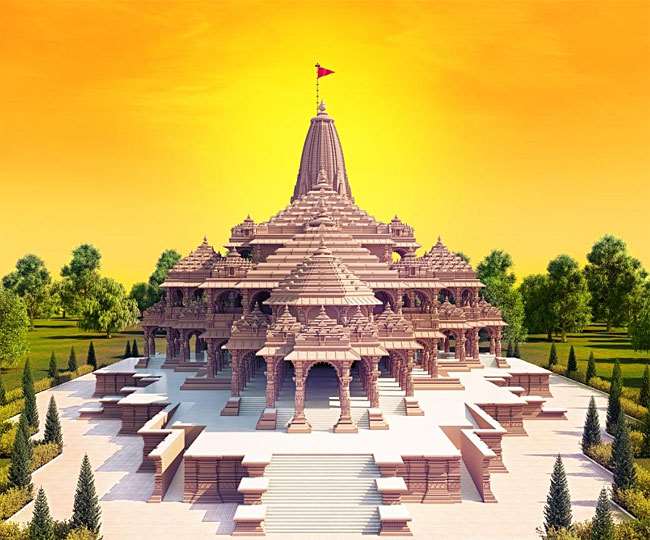The Ram Mandir legacy
Will this be untouched by outsiders once its constructed?! Ladies and Gentlemen, i put it to you. The historic Bhumi Pujan thats about to commence in a few short minutes at the heart of Ayodhya. Yes, its a very exciting and celebratory prospect for the vast majority of ardent religious Indians. the way the halls have been decked with such great pomp and fanfare is actually eclipsed by a great deal of controversies and rich historical significance. Will it last in the eyes of god? IS the Bhumi Pujan a new beginning for the history of RamJanmabhoomi? Are we ushering in a new era?
1) The location and name of RamJanmabhoomi: As the name suggest, the land is supposed to be postulated as the birthplace of Lord Ram from the Hindu mythology. So, it is only fitting to pay homage to the deity of Lord Ram by immortalizing a temple in his honour and name.

2) The Ayodhya dispute:In the bygone era, there were numerous temples built on this very favorable stretch of land nestled in Uttar Pradesh. A timeline of events that took place that led to this debilitating dispute are as follows:
in 1528, the Babri Masjid(a mosque ceremonial to the Muslims and the Mughals) was constructed upon orders by the then Emperor Babur, which was famed to have been constructed on the site of Rama's birthplace by shattering and completely reducing to rubble the temple devoted to Lord Rama.
These frivolous sentiments harboured by the Mughals has led to a long-drawn battle between the Hindus and the Muslims. And in 1611, we get to see s documented version of Rama's castle and the houses frequented by pilgrims.
in the year of 1717- A Rajput nobleman Jai Singh II bought the rights of the Muslim land and vested it in the deity. The Hindus were given a golden opportunity to pay their obeiscances and worship their gods outside the mosque. These clashes between the two communities went on for years and years, without coming to a truce or consensus. Ultimately, the court decided to take apex control of the issue and here we are, heralding its glorious inaugration. This was also when the Sunni Waqf board had to intervene in lieu of the Babri Masjid matter.
After relentless courts appeals and injunctions filed, we now have some closure. The fact that it is a Hindu-dominated land and will always remain to be one is an unparalleled legacy on its own. Today's is merely a veneer that seperates the trauma underwent by the two warring communities put to a jarring halt.The construction is now underway. Possibly we get to see this wonderful Pandora's Box of how untainted our cultural ties are. Despite being the cynosure of all eyes, perpetually embroiled in controversy over race and ethnicity, we perhaps get to dedicate a massive chunk of our life towards Lord Ram. Jai Shri Ram. May goodness prevail. The river Sarayu will replenish Ayodhya in the days to come.
This is bound to go down in history. Jai Hind. Mera Bharat Mahaan.

1) The location and name of RamJanmabhoomi: As the name suggest, the land is supposed to be postulated as the birthplace of Lord Ram from the Hindu mythology. So, it is only fitting to pay homage to the deity of Lord Ram by immortalizing a temple in his honour and name.

2) The Ayodhya dispute:In the bygone era, there were numerous temples built on this very favorable stretch of land nestled in Uttar Pradesh. A timeline of events that took place that led to this debilitating dispute are as follows:
in 1528, the Babri Masjid(a mosque ceremonial to the Muslims and the Mughals) was constructed upon orders by the then Emperor Babur, which was famed to have been constructed on the site of Rama's birthplace by shattering and completely reducing to rubble the temple devoted to Lord Rama.
These frivolous sentiments harboured by the Mughals has led to a long-drawn battle between the Hindus and the Muslims. And in 1611, we get to see s documented version of Rama's castle and the houses frequented by pilgrims.
in the year of 1717- A Rajput nobleman Jai Singh II bought the rights of the Muslim land and vested it in the deity. The Hindus were given a golden opportunity to pay their obeiscances and worship their gods outside the mosque. These clashes between the two communities went on for years and years, without coming to a truce or consensus. Ultimately, the court decided to take apex control of the issue and here we are, heralding its glorious inaugration. This was also when the Sunni Waqf board had to intervene in lieu of the Babri Masjid matter.
After relentless courts appeals and injunctions filed, we now have some closure. The fact that it is a Hindu-dominated land and will always remain to be one is an unparalleled legacy on its own. Today's is merely a veneer that seperates the trauma underwent by the two warring communities put to a jarring halt.The construction is now underway. Possibly we get to see this wonderful Pandora's Box of how untainted our cultural ties are. Despite being the cynosure of all eyes, perpetually embroiled in controversy over race and ethnicity, we perhaps get to dedicate a massive chunk of our life towards Lord Ram. Jai Shri Ram. May goodness prevail. The river Sarayu will replenish Ayodhya in the days to come.
This is bound to go down in history. Jai Hind. Mera Bharat Mahaan.

Comments
Post a Comment